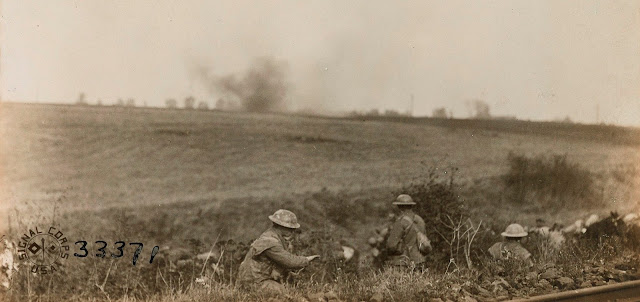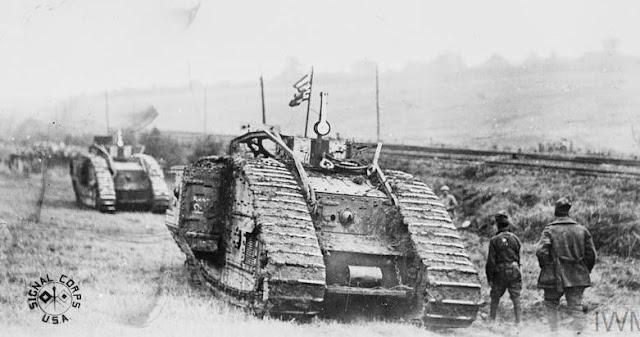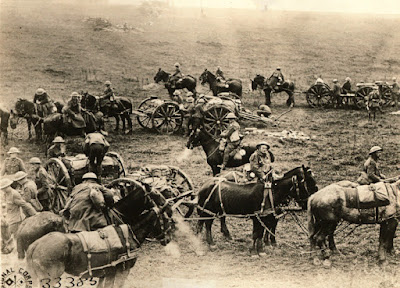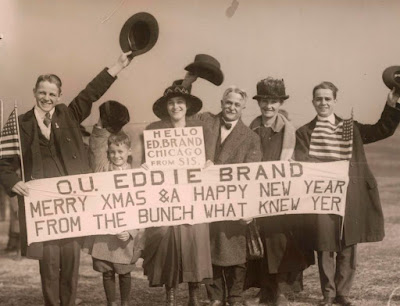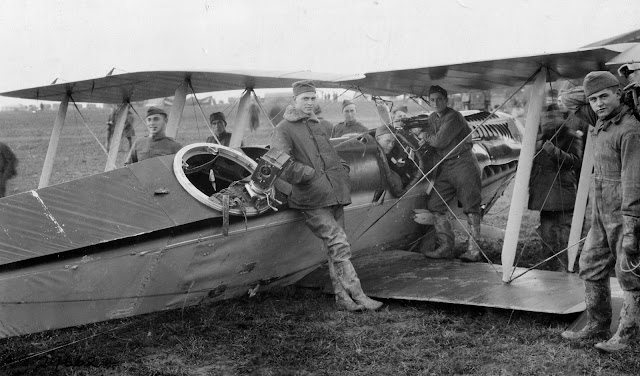For this final weblog here is a reproduction of a post that was published in November 2017 by the International Association for Media and History (IAMHIST) on their website.
 |
Albert Dawson, directing war movies on the Eastern Front, 1915. Source: National ArchivesLink to high res image |
"Researching World War I On Film"
By Ron van Dopperen
The centennial of the First World War has brought about a renewed public interest in this major military conflict. When I first visited Belgium as a history student in the 1980s there were still veterans around who had been in the trenches. They were there to hear the Last Post under the Menin Gate, and I remember vividly how impressed I was by the ceremony and the sight of all these names of the soldiers who had found an anonymous grave in the Ypres Salient.
As the saying goes ‘Old soldiers never die, they simply fade away’. It is the same with the films of the Great War. Stored on highly flammable nitrate stock, the film legacy of World War I presents scholars and film fans all over the world with an amazing historical source. The footage to be sure is slowly fading away. Unless preserved on safety stock or digitized we are losing by decomposition an invaluable part of our cultural heritage. I recall the first time I went into the nitrate vaults of the Library of Congress in Culpeper, Virginia, with my esteemed fellow author Cooper Graham, looking for lost film of this war. I was feeling like a kid in a candy store. In one of the cans we found footage mentioning The German Side of the War, a movie that had been produced by the Chicago Tribune in 1915. When reeling that film on a viewer we found ourselves in underground bunkers on the Eastern Front, and that’s when we discovered the film had been misplaced. We were looking at a completely different film that was shot by Albert K. Dawson, cameraman with the Austro-Hungarian army!
My fascination with these old war films started when as a history student I first read Kevin Brownlow’s book The War, the West and the Wilderness. Kevin is one of the first historians to research World War I films. He also was fortunate enough to interview some of the cameramen who recorded the Great War, at a time when they were still around. We dedicated our book American Cinematographers in the Great War to Kevin Brownlow because as film historians we all stand on his shoulders. These war pictures, as described by Brownlow, were a window on a different world. This was a time when cars and planes were the latest thing, when women could not vote, when it took ten days to cross the Atlantic, when trench warfare devastated a way of life that belonged to the 19th century. Despite the static shots and primitive camera technique these films and newsreels are truly mesmerizing.
The First World War was a modern war that surprised all combatants as well as the people at the home front just because it was so ‘modern’. It was also the first modern media war. Film propaganda was not invented by Goebbels but by Wellington House, UFA and the Committee on Public Information in America. Admittedly, wars had been filmed before 1914 but this was the first time in history when the huge publicity potential of this young medium was discovered and exploited.
As I dug deeper into my film research, together with my American colleagues Cooper Graham and Jim Castellan, I also got intrigued by one simple question: how did these guys do it? How did they manage lugging these cumbersome movie cameras with tripod and all to the battlefield? How did they deal with censors, military red tape and the risks of having their movie camera mistaken for the equipment of an artillery spotter? Why did they even run the risk of becoming a prime target? We were on uncharted territory basically, as most of these cameramen – like the soldiers of World War I – had slowly faded away. We interviewed relatives in the U.S. and many of them did not even know that their Granddad had been a cameraman in World War I. But the stories that we found on their photographic work and their life are definitely worth preserving, just like their films. In some rare instances we could even match their personal story with the pictures that they made at the front. It’s a strange experience to watch a movie that was made one hundred years ago, as seen through the eyes of the cameraman you get to know so well. As a writer you feel transported back in time. For a brief moment you become the cameraman.
Just like these cameramen who had been pioneers in their trade – the first film correspondents – we had to start most of our film research from scratch. I should give proper credits here to Cooper and Jim for their outstanding work on reconstructing Wilbur H. Durborough’s feature film, On the Firing Line with the Germans, a unique film report made during the German drive on the Eastern Front in 1915. By using the paper roll collection at the Library of Congress they managed to identify each separate scene from that movie. The next step was finding scenes missing from known Durborough film in TV documentaries and the World War I Signal Corps collection at the National Archives. The last step was piecing them all together in the right order. This is another aspect of this kind of film research: how to piece all of these segments together? World War I film research is a giant jigsaw puzzle because a lot of contemporary footage has been recycled or cut into stock footage. It takes a lot of patience to get the bigger picture.
 |
Sniper attack on the Eastern Front in Russian Poland. Scene from On the Firing Line with the Germans (USA, 1915)Link to high res image |
The last years researching World War I film have been a great ride. We have brought back on the screen Durborough’s war film which has been wonderfully restored by the Library of Congress. The premiere at the film festival of Pordenone together with Kevin Brownlow as a special guest was just great. This kind of film research never really stops, so after publishing our books and articles we started a weblog Shooting the Great War which has the latest updates on World War I cameramen and films that we have found and identified. The blog has over 350.000 views. So, we definitely have an audience out there!
For a download in PDF of all contents in this weblog click this link (112 Mb, 294 pages)
Ron van Dopperen studied history at the University of Utrecht (Holland) where he wrote his Master of Arts Thesis on the American World War I documentary films. Since 2011 he publishes on World War I film, starting with a series of articles for Film History journal. He is also co-author together with Cooper C. Graham of Shooting the Great War: Albert Dawson and the American Correspondent Film Company (2013) and together with Jim Castellan and Cooper Graham of American Cinematographers in the Great War (2014) which was sponsored by the Pordenone Silent Film Festival.

